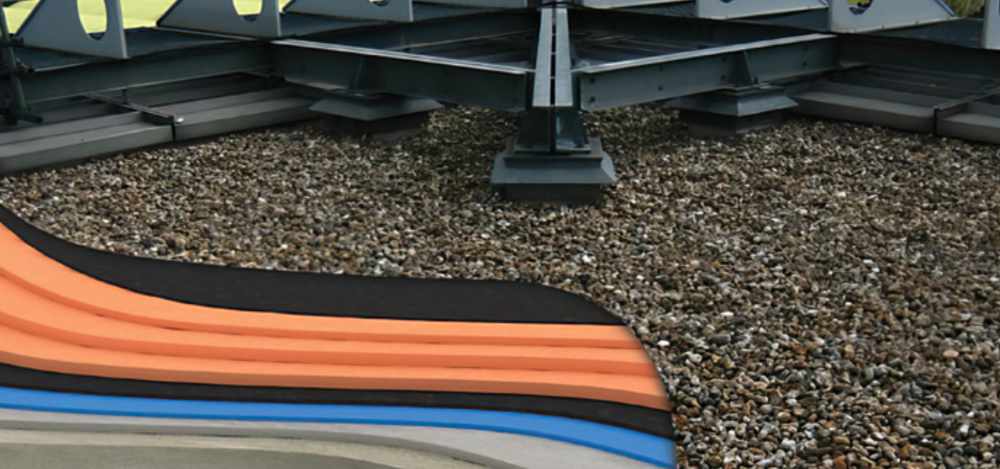Hybrid flat roofs
[edit] Hybrid flat roofs – when flat roof specification becomes compromised?
Warm roofs – whether a ‘conventional’ or inverted build-up – should be the specification of choice for new-build flat roofs that need to be insulated. However, mistakes in specification, or height issues on site, can necessitate considering installing insulation to the underside of the deck. Is the subsequent result – known as a ‘hybrid’ roof – ever an appropriate solution?
The type of insulation added to the warm roof arrangement, and the way it’s installed, depends on the roof deck.
• Timber deck: Rigid foam insulation or batts of mineral wool insulation are likely to be friction-fitted between the roof joists, and a ceiling finish fixed to the underside of the joists.
• Concrete and metal decks: The chosen insulation type must be capable of being fixed securely to the underside of the deck, with the question of how a ceiling is then provided.
[edit] Do existing standards and guidance support hybrid flat roofs?
We are not aware of any formal guidance that specifically forbids or rules out hybrid roof arrangements. Two main British Standards are relevant here. Both are codes of practice, so their contents constitute ‘guidance and recommendations’, rather than formal requirements/ specifications.
[edit] BS 6229:2018 Flat roofs with continuously supported flexible waterproof coverings
Code of practice acknowledges that hybrid roof build-ups occur, such as where thermal insulation is added to an existing roof. It says there is “an increased risk of interstitial condensation with a hybrid roof”, but stops short of saying they are bad practice. Nevertheless, designers “should select the type of flat roof most suitable for the intended building”, which means ensuring that any condensation risk present is fully assessed and evaluated.
[edit] BS 5250:2021 Management of moisture in buildings
Code of practice represented a substantial revision to the previous version of BS 5250. It features a table summarising the condensation risk analysis methods appropriate for warm flat roofs, and the 2021 update included a new footnote. Footnote B to Table 4 says that condensation risk analysis calculations are required for warm flat roofs “if thermal insulation is split both above and below the deck or AVCL although typically no more than one-third of the thermal resistance should be on the warm side of the AVCL.”
The term ‘hybrid flat roof’ is not used in the standard, only this description of one. The ‘one-third rule’ described here has been a rule of thumb in the industry for years. Again, though, we are not aware of it being something ever previously formalised. Where the under-deck insulation is the same material, and has the same thermal conductivity, as the insulation on the deck, then a ‘one-third calculation’ is simple. If the two insulation layers have different performance characteristics then the calculation is much less straightforward. In addition, any thermal bridges through the insulation layer – timber joists, air gaps, fixings – change the effective R-value of the layer. Have they been taken into account? Does BS 5250 intend for them to be taken account? This is where hybrid roofs become a minefield.
[edit] Do hybrid flat roofs contribute to the performance gap?
The 2021 edition of BS 5250 therefore appears to lend some legitimacy to hybrid roofs as a concept, having not included such a statement in the 2016 edition. Despite this, there are strong arguments for approaching hybrid roofs with a good deal of caution, and even avoiding them entirely, as BS 6229 seems to lean towards.
The translation of design intent to as-built performance is a fundamental issue for the construction industry as a whole. No form of construction or installation is immune from potential performance gap issues. In the case of hybrid flat roofs, however, there are clear reasons why a performance gap is more likely to occur – and equally clear practical consequences if installation is not carried out to the highest standard.
By installing insulation not just on the warm side of the roof deck, but also on the warm side of the air and vapour control layer (AVCL), potential issues with condensation are being invited where they are very much not welcome.
[edit] Analysing condensation risk in hybrid roofs
BS 5250:2021 describes appropriate condensation risk analysis tools for different flat roof build-ups. These tools are only ever models and site practice needs to at least try and match what was assumed in the analysis – something that is by no means guaranteed in any aspect of construction. The dewpoint charts produced when analysing hybrid flat roofs can be hard to read. The temperature and dewpoint lines might be very close, and even touching – regardless of whether the calculation predicts any condensation. The Polyfoam XPS technical helpdesk has dealt with plenty of project enquiries where the proposed insulation arrangements result in a prediction of condensation risk. We are then asked to adjust a proposed hybrid roof specification by a matter of degrees at a time, reducing the thickness of under-deck insulation until the calculation no longer predicts condensation.
Such ‘massaging’ of input data is extremely questionable. If the difference between predicting condensation and not predicting condensation is decreasing the insulation thickness by just 5mm, are you really confident that the latter build-up will perform in reality? Ultimately, you are relying on near-flawless installation of the ‘safe’ or ‘acceptable’ arrangement to make sure the as-built roof performs as intended.
[edit] What are the potential installation issues in hybrid flat roofs?
[edit] Air gaps
Insulation installed between roof joists must be tightly fitting to avoid warm air potentially circulating around it. The potential for moisture transport is exacerbated if the insulation material itself is vapour open.
[edit] Fixings
Where insulation has to be fixed to the underside of the deck, what type and frequency of mechanical fixings will be used? How will the ceiling be fixed through the insulation and into the deck? Can a continuous layer of insulation sensibly be achieved?
On the subject of fixings, suspended ceilings are a particular cause for concern. We frequently see U-values calculation that assume either no suspended ceiling fixings through the under-deck insulation layer, or minimal impact on the insulation layer. What if a ceiling system needs more supports when it is being installed than the calculation assumed? What if the penetrations made through the insulation are done untidily, and leave large holes in the insulation rather than being kept neat and tidy?
[edit] In summary
If they are not exactly desirable, then it is at least easy to see why hybrid flat roofs get built. Dealing with tight upstand heights on the roof? Need a lower U-value without taking up the waterproofing? Then insulation below the deck is an obvious route to explore. Unfortunately, the convenient solution is often too good to be true.
A worrying development we have seen in hybrid roof calculations is a highly vapour resistant insulation layer shown to the underside of the roof deck. This layer is significantly thicker than the insulation above the roof deck, going far beyond the bounds of the ‘one-third rule’.
The calculation ‘works’ because the below-deck insulation is assumed to be continuous and offering perfect vapour resistance. However, we have seen examples of such calculations where a suspended ceiling system is present. How does the system fix through the insulation without compromising the perfect vapour resistance that is being relied upon?
It is concerning to see a hybrid solution, which already is not considered best practice, being deviated from even further to address what good design and specification should avoid in the first place. In theory, hybrid flat roofs can work – but can they be trusted to work in the majority of cases where they are adopted? At Polyfoam XPS, we therefore maintain the stance that hybrid roofs should be a design choice of last resort, to avoid compromising the performance of a major building element.
This article appears in the AT Journal issue 148, published in Winter 2023 as 'Hybrid flat roofs – when flat roof specification becomes compromised?' it was written by Rob Firman, Technical and Specification Manager, PolyFoam XPS.
--CIAT
[edit] Related articles on Designing Buildings
Featured articles and news
RTPI leader to become new CIOB Chief Executive Officer
Dr Victoria Hills MRTPI, FICE to take over after Caroline Gumble’s departure.
Social and affordable housing, a long term plan for delivery
The “Delivering a Decade of Renewal for Social and Affordable Housing” strategy sets out future path.
A change to adoptive architecture
Effects of global weather warming on architectural detailing, material choice and human interaction.
The proposed publicly owned and backed subsidiary of Homes England, to facilitate new homes.
How big is the problem and what can we do to mitigate the effects?
Overheating guidance and tools for building designers
A number of cool guides to help with the heat.
The UK's Modern Industrial Strategy: A 10 year plan
Previous consultation criticism, current key elements and general support with some persisting reservations.
Building Safety Regulator reforms
New roles, new staff and a new fast track service pave the way for a single construction regulator.
Architectural Technologist CPDs and Communications
CIAT CPD… and how you can do it!
Cooling centres and cool spaces
Managing extreme heat in cities by directing the public to places for heat stress relief and water sources.
Winter gardens: A brief history and warm variations
Extending the season with glass in different forms and terms.
Restoring Great Yarmouth's Winter Gardens
Transforming one of the least sustainable constructions imaginable.
Construction Skills Mission Board launch sector drive
Newly formed government and industry collaboration set strategy for recruiting an additional 100,000 construction workers a year.
New Architects Code comes into effect in September 2025
ARB Architects Code of Conduct and Practice available with ongoing consultation regarding guidance.
Welsh Skills Body (Medr) launches ambitious plan
The new skills body brings together funding and regulation of tertiary education and research for the devolved nation.
Paul Gandy FCIOB announced as next CIOB President
Former Tilbury Douglas CEO takes helm.
UK Infrastructure: A 10 Year Strategy. In brief with reactions
With the National Infrastructure and Service Transformation Authority (NISTA).

























